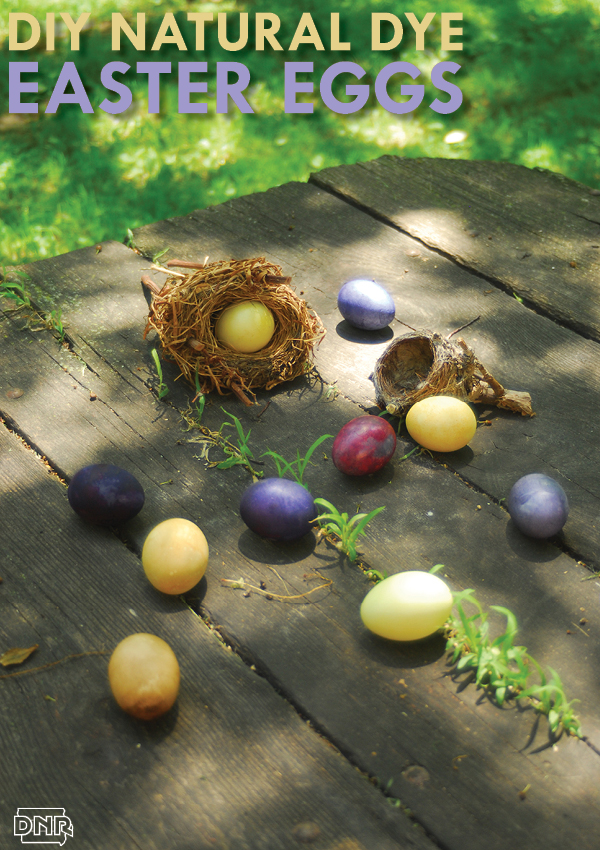 Create super intense Easter eggs that outshine those made with store-bought dyes with these foraged, natural dyes. Get outside with a friend or loved one to gather plants and brew a tempest of color. The dyes are easily frozen for later use.
Create super intense Easter eggs that outshine those made with store-bought dyes with these foraged, natural dyes. Get outside with a friend or loved one to gather plants and brew a tempest of color. The dyes are easily frozen for later use.
Make double batches for other projects, such as tinting fabrics and shirts. (Alum, common in grocery store spice aisles, sets colors to prevent running. To stain fabric, add a teaspoon of alum per cup of dye and simmer for 10 minutes).
You’ll want to save this list for next fall, when you can turn it into a scavenger hunt to collect the items needed for next spring’s dyes.
Larry Reis, a Winneshiek County naturalist, is locally renowned for his beautiful hand-made dyes. After steeping black cherry, elderberry and wild grapes, cottonwood leaves and wild sunflower petals, he brews up a riot of colors and places the pigment-loaded tinctures in freezer bags for storage until Easter. Here are his tips:
Here’s what to harvest in the fall
“You only need a quart of berries,” to concoct dye, says Reis. Black cherry, elderberry and wild grape berries offer a riot of colors. Search woodlot edges for low-branched black cherry trees to churn out a burgundy red dye. Peep around for elderberries in wetter habitats in low-lying, wild areas to make steel blue-grey colors. Use wild grape berries for royal purple tints.
Hike along river bottoms, hedgerows and fencelines to pluck, nibble and gather a quart for dye. (Obtain landowner permission and leave enough berries, nuts and leaves for wildlife.)
To make: Smash berry types separately, add to a pan with several cups of water and simmer 20-30 minutes to extract pigments. Strain the colorful juice through a triple layer of cheese cloth. Cool and place in a Ziploc bag and freeze. Follow the same procedure for the species below.
Walnut, butternut and hickory create intense chocolate, tan and olive-brown shades. For walnuts, “shuck off the husk, that green yucky part,” says Reis. “When they start to decompose they are easier to husk.”
Use the pigment-rich husks for dye. Green hickory nuts are easier to husk than older nuts. Allow butternuts to sit and ferment to aid husk removal. An ice-cream pails’ worth creates 2-3 cups of dye.
Gather an ice-cream pail of cottonwood leaves to produce pale yellow dye. Wild sunflowers make orange-yellow dye. Place whole into water and simmer 30 minutes. Gather a gallon of goldenrod flower plumes for a true lemon yellow dye. Pick a gallon of milkweed leaves to create orange-yellow dye, again steeping 20-30 minutes.
Reis shares his spring secrets for neat and clean egg dying:
1) Place freezer bags with frozen dyes into a hot water bath.
2) When thawed, add a tablespoon of vinegar for each 2-3 cups of dye. The acids in vinegar help open eggshell pores to allow better dye penetration.
3) Fill a cooking pot one-third full with water. On a stovetop, bring the pot to a simmer. Place bags of dye in pot.
4) To minimize cleanup, place hard-boiled eggs directly in sealable freezer bags to prevent dye from staining pots.
5) Experiment with dyeing times. “Elderberry dye produces a steel gray egg with a short steep,” says Reis. Wild grape’s purple dye needs just a quick dunk for a light red, or steep longer for brick reds. Sunflower petal dye yields pale yellows with a quick dunk, or longer soaks for super-saturated, intense yellows. The browns from walnut, hickory and butternut yield rich color with longer soaking times. “Have fun and play around with the coloring times,” says Reis.
After Easter, reuse shells by emptying egg matter and cutting shell in half. Fill half shell with soil and plant a wildflower or garden seed inside. The brilliantly colored little planters can be partially crushed to prevent root balling just before planting, then placed directly in the ground. The shell provides nutrients to the soil to nurture the young plant.
Don’t eat the eggs. The natural dyes aren’t sterile and walnuts picked from the forest floor may be contaminated with animal droppings, says Reis. “I don’t know that it’s bad, it’s just a general safety precaution,” he says.
These articles originally ran in the Sept/Oct 2007 and March/April 2008 issues of Iowa Outdoors magazine.
Learn more on Pinterest with our DIY Outdoors, We Love Spring in Iowa and Iowa Outdoors Magazine boards.